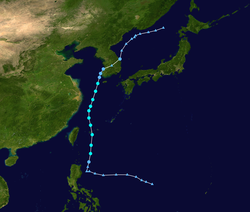Tropical Storm Danas (2019)
The topic of this article may not meet Wikipedia's notability guideline for events. (August 2021) |
| Tropical storm (JMA scale) | |
|---|---|
| Tropical storm (SSHWS) | |
 | |
| Formed | July 14, 2019 |
| Dissipated | July 21, 2019 |
| Highest winds | 10-minute sustained: 85 km/h (50 mph) 1-minute sustained: 75 km/h (45 mph) |
| Lowest pressure | 985 hPa (mbar); 29.09 inHg |
| Fatalities | 6 total |
| Areas affected | Philippines, Taiwan, China, Japan, South Korea |
| Part of the 2019 Pacific typhoon season | |
Tropical Storm Danas, known as Tropical Storm Falcon in the Philippines, was the fifth named tropical cyclone of the 2019 Pacific typhoon season.
Storm history[]

Tropical storm (39–73 mph, 63–118 km/h)
Category 1 (74–95 mph, 119–153 km/h)
Category 2 (96–110 mph, 154–177 km/h)
Category 3 (111–129 mph, 178–208 km/h)
Category 4 (130–156 mph, 209–251 km/h)
Category 5 (≥157 mph, ≥252 km/h)
Unknown
On July 11, a low-pressure zone formed near the Mariana Islands, and the United States Naval Research Laboratory began tracking the system. On the morning of July 14, the Japan Meteorological Agency (JMA) upgraded it to a tropical depression. At this point the system moved westward.[citation needed] At 8 pm, the Joint Typhoon Warning Center gave the system a low chance for tropical cyclogenesis. On the morning of July 15, the JMA issued a gale warning, and the Central Weather Bureau (CWB) of Taiwan upgraded it to a tropical depression. On the same day, the Hong Kong Observatory upgraded the storm to a tropical depression.[citation needed]
At 6:30 am on July 16, the Joint Typhoon Warning Center upgraded the rating to "High" and issued a tropical cyclone warning. The Joint Typhoon Warning Center raised the system to a tropical depression at 2:40 pm, giving the number 06W.[citation needed] At 3 pm on the same day, the Japan Meteorological Agency upgraded it to a tropical storm, naming it Danas, followed by the , the CWB, and PAGASA also upgraded it to a tropical storm. The Joint Typhoon Warning Center was upgraded to a tropical storm late that night.[citation needed]
On July 19, the JMA reported that Danas had reached its peak wind speeds with maximum 10-minute sustained winds of 85 km/h (50 mph). Later that day, Danas began to weaken. On July 20, around 13:00 UTC, Danas made landfall in South Korea as a minimal tropical storm, before weakening into a tropical depression soon afterward.[citation needed] The weakening trend also accelerated on July 20 due to the drop in sea surface temperatures to 23 °C (73 °F) near landfall. The Republic of Korea Meteorological Administration downgraded Danas to a tropical depression at 11 am and stopped issuing announcements.[1] At 12:45 UTC on July 21, Danas transitioned into an extratropical low in the Sea of Japan, and the JMA issued their final advisory on the storm.[citation needed]
Impact[]
Philippines[]
In the Philippines, four people were killed after Danas triggered flooding in the country.[2] Agricultural damage in Negros Occidental were calculated at ₱19 million (US$372,000),[3] while agricultural damage in Lanao Norte reached ₱277.8 million (US$5.44 million).[4]
South Korea[]
Danas caused stormy weather across South Korea; however, its effects were relatively minor. Heavy rains amounted to 329.5 mm (12.97 in) in Geomun-do.[5] A man died after being swept away by strong waves in Geochang County.[6] Damage in South Jeolla Province were at W395 million (US$336,000),[7] while damage in Jeju Island up to W322 million (US$274,000).[8] Additionally, Danas also triggered flash flooding in Kyushu. An 11-year-old boy was killed.[9]
Japan[]
Danas brought heavy rainfall to many western parts of Japan including nearly all of Kyushu. In addition, the amount of rain that fell in the last 24 hours exceeded 350 mm in various places in Goto, and reaches the rainfall for July 1 month in normal years, and it has become the largest since July.[10]
See also[]
References[]
- ^ 강찬수 (2019-07-20). "태풍 다나스, 육지 못 밟았다···전남 신안 섬지역서 소멸" (in Korean). 中央日報. Retrieved 2019-07-20.
- ^ "'Falcon' leaves 4 dead". Philippine Daily Inquirer. July 19, 2019. Retrieved July 20, 2019.
- ^ Nicavera, Erwin P. (August 5, 2019). "Rains, flooding slash almost ₱19M in Negros Occidental agriculture". Sun Star. Retrieved August 6, 2019.
- ^ Jerusalem, Jigger (August 1, 2019). "'Falcon' destroys P277-M in Lanao Norte". Philippine News Agency. Retrieved August 2, 2019.
- ^ "태풍 다나스 열대저압부로 소멸…광주·전남 태풍경보 해제" (in Korean). Yonhap News Agency. July 20, 2019. Retrieved August 6, 2019.
- ^ Kim, Arin (July 21, 2019). "One found dead as typhoon alert lifted". The Korea Herald. Retrieved July 24, 2019.
- ^ 양창희 (August 5, 2019). "태풍 '다나스' 시설물 피해액, 3억 9천여만 원" (in Korean). KBS News. Retrieved August 6, 2019.
- ^ 김승범 (August 13, 2019). "제5호 태풍 '다나스' 피해복구액 31억원 잠정 집계" (in Korean). Jeju News. Retrieved August 16, 2019.
- ^ "1 dead, 57,000 people ordered to evacuate from rain in Kyushu". The Asahi Shimbun. July 21, 2019. Retrieved July 24, 2019.
- ^ "Action to protect heavy rain special warning life in Goto, Nagasaki Prefecture" (in Japanese). Archived from the original on 2019-07-20. Retrieved 2019-07-21.
- 2019 Pacific typhoon season
- Western Pacific tropical storms
